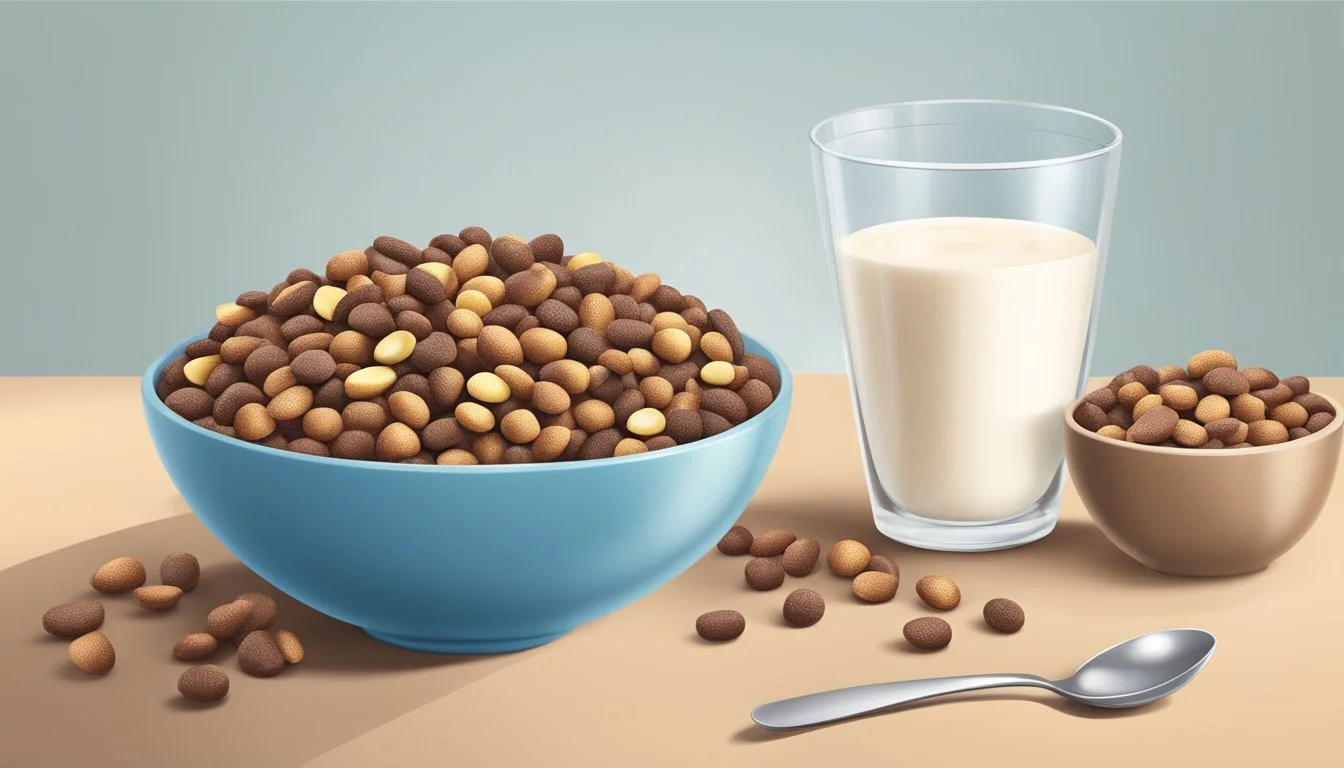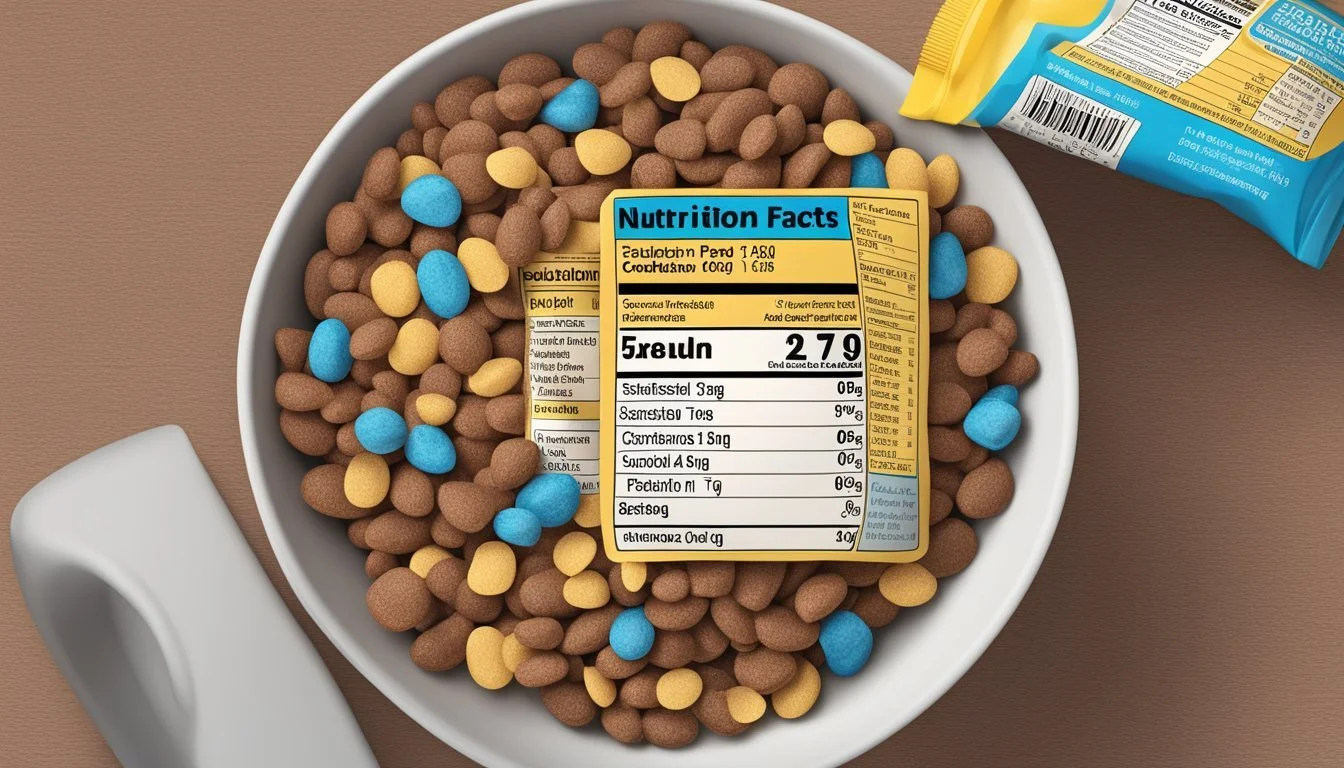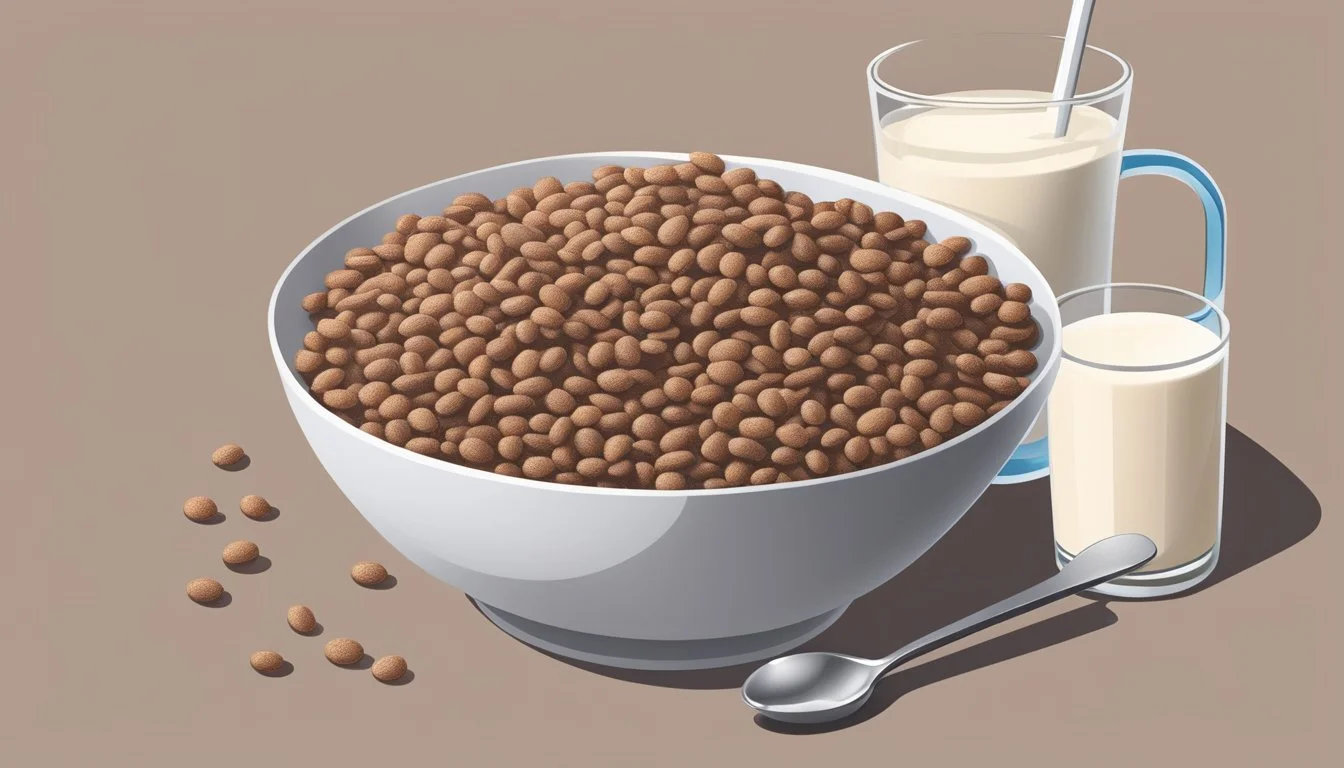Cocoa Pebbles Nutrition Facts & More
Essential Facts for Cereal Lovers
Cocoa Pebbles, a beloved breakfast cereal, has been delighting chocolate lovers for decades. This crispy rice cereal offers a chocolatey start to the day for both kids and adults alike. A 1-cup serving (36 grams) of Cocoa Pebbles contains 140 calories, with 31 grams of carbohydrates, 2 grams of protein, and 1.5 grams of fat.
The cereal's main ingredients include rice, sugar, and cocoa processed with alkali. While it's a tasty treat, Cocoa Pebbles is relatively high in sugar content. The nutrition facts reveal that carbohydrates make up 85% of the calorie content, with protein and fat contributing 5% and 9% respectively.
For those watching their nutrient intake, Cocoa Pebbles does contain small amounts of vitamins and minerals. However, its primary appeal lies in its chocolatey flavor rather than its nutritional profile. Consumers seeking a balanced breakfast may want to consider pairing Cocoa Pebbles with protein-rich foods or fresh fruits for a more well-rounded meal.
Cocoa Pebbles Compared to Other Breakfast Cereals
Nutritional Profile
Cocoa Pebbles cereal provides a mix of macronutrients, vitamins, and minerals. It contains moderate calories and carbohydrates, with added sugars and fortified nutrients.
Macronutrient Breakdown
A 3/4 cup (30g) serving of Cocoa Pebbles contains 140 calories. The primary macronutrient is carbohydrates, with 28g per serving. This accounts for about 10% of the daily value based on a 2,000 calorie diet.
Total sugars make up 12g of the carbohydrates, with added sugars contributing significantly. The cereal provides 1g of protein and 1.5g of total fat per serving.
Fiber content is relatively low at 1g per serving, representing 4% of the daily value. This nutritional composition makes Cocoa Pebbles a high-carb, low-protein, and low-fat breakfast option.
Vitamins
Cocoa Pebbles is fortified with several essential vitamins:
Vitamin D: 10% DV
Vitamin B12: 25% DV
Vitamin A: 10% DV
Vitamin B6: 10% DV
Other B vitamins present include thiamin (vitamin B1), riboflavin (vitamin B2), and niacin (vitamin B3). The cereal does not contain significant amounts of vitamins C, E, or K.
These added vitamins enhance the nutritional value of the cereal, supporting various bodily functions such as immune health, energy metabolism, and cell growth.
Minerals
The mineral content of Cocoa Pebbles includes:
Iron: 50% DV
Zinc: 10% DV
Calcium: 10% DV
Iron is notably high, providing half of the daily recommended intake. This is beneficial for oxygen transport in the body and preventing anemia.
Calcium supports bone health, while zinc plays a role in immune function and wound healing. The cereal also contains small amounts of phosphorus and sodium.
Fats Content
Cocoa Pebbles has a low fat content, with 1.5g of total fat per serving. This represents 2% of the daily value. The fat profile includes:
Saturated fat: 1.4g
Trans fat: 0g
Monounsaturated fat: 0.1g
Polyunsaturated fat: 0g
The majority of the fat is saturated, primarily from the cocoa content. The cereal contains no trans fats, which aligns with current dietary recommendations to minimize trans fat intake.
The low overall fat content contributes to the cereal's relatively low calorie count per serving.
Ingredient Analysis
Cocoa Pebbles cereal contains a mix of basic grains, sweeteners, flavorings, and preservatives. Understanding the key components provides insight into the nutritional profile and potential health impacts of this popular breakfast food.
Core Ingredients
Rice serves as the primary ingredient in Cocoa Pebbles, providing the cereal's crispy texture and base. Sugar follows as the second most abundant ingredient, contributing to the sweet taste. Cocoa powder, processed with alkali, gives the cereal its signature chocolate flavor. Canola or soybean oil is added to enhance texture and mouthfeel.
These core ingredients form the foundation of Cocoa Pebbles' taste and structure. The rice offers some nutritional value, while the sugar and oils primarily contribute calories without significant vitamins or minerals.
Additives and Preservatives
Cocoa Pebbles contains several additives to improve flavor, appearance, and shelf life. Salt enhances taste, while caramel color provides a deeper brown hue. Natural and artificial flavors intensify the chocolate profile.
BHT (butylated hydroxytoluene) is added as a preservative to maintain freshness. This synthetic antioxidant prevents oils in the cereal from becoming rancid. While approved for use in food, some consumers prefer products without artificial preservatives.
Allergens and Dietary Considerations
Cocoa Pebbles is marketed as a gluten-free cereal, making it suitable for individuals with celiac disease or gluten sensitivity. The product is also vegan, containing no animal-derived ingredients.
However, people with soy allergies should note the potential presence of soybean oil. Those watching their sugar intake may want to be cautious, as sugar is the second most prominent ingredient. The cereal does not contain common allergens like nuts, dairy, or eggs.
Consumers following kosher diets can enjoy Cocoa Pebbles, as it is typically certified kosher.
Health Implications
Cocoa Pebbles cereal has both positive and negative impacts on health. Its micronutrient content provides some benefits, while the high sugar and low fiber content raise concerns.
Micronutrients Impact
Cocoa Pebbles contains several important vitamins and minerals. Iron is present, supporting oxygen transport in the body. The cereal is fortified with B vitamins like niacinamide, thiamin, and riboflavin, which play roles in energy metabolism.
Vitamin A palmitate is added, promoting eye health and immune function. Zinc oxide contributes to immune support and wound healing. These micronutrients offer some nutritional value to consumers.
However, the cereal's processing may reduce the bioavailability of certain nutrients. Natural food sources often provide more readily absorbed vitamins and minerals.
Sugar and Fats
Sugar is the second ingredient in Cocoa Pebbles, indicating a high content. Excessive sugar intake is linked to obesity, diabetes, and tooth decay. The cereal contains 12 grams of sugar per serving, which is nearly 25% of the recommended daily limit for added sugars.
Saturated fat content is low at 0 grams per serving. The cereal contains no trans fats, which is beneficial for heart health. Canola oil provides some unsaturated fats.
Dietary fiber is minimal in Cocoa Pebbles, at less than 1 gram per serving. This low fiber content may contribute to rapid blood sugar spikes after consumption.
Sodium levels are moderate at 220mg per serving, or about 10% of the daily recommended limit. Excessive sodium intake can contribute to high blood pressure in some individuals.
Label and Regulations
Cocoa Pebbles cereal packaging features detailed nutrition labeling and adheres to food manufacturing regulations. These elements provide consumers with essential information and ensure product safety.
Nutrition Labeling
The Nutrition Facts panel on Cocoa Pebbles boxes displays key nutritional information. It lists serving size, calories, and nutrient content per serving. The label shows total fat, sodium, total carbohydrates, and protein amounts.
Daily Value percentages are included for certain nutrients. These help consumers understand how the cereal fits into their overall diet. The label also specifies added sugars, an important consideration for many shoppers.
Ingredient lists appear on the packaging, detailing components like rice, sugar, and oils used in production.
Manufacturer Compliance
Post, the manufacturer of Cocoa Pebbles, must follow strict FDA regulations for food labeling and production. These rules ensure accuracy in nutrition information and ingredient disclosure.
The company is required to use standardized serving sizes for consistent comparisons across cereal brands. Post must also comply with food safety protocols in manufacturing and packaging processes.
Regular inspections and quality control measures are implemented to maintain compliance. This includes proper allergen labeling and adherence to permitted food additives and colorings regulations.
Consumption Recommendations
Cocoa Pebbles should be enjoyed in moderation as part of a balanced diet. Proper portion control and mindful eating habits are key to incorporating this cereal into a nutritious meal plan.
Serving Size and Frequency
The recommended serving size for Cocoa Pebbles is 3/4 cup (36g). This amount provides 140 calories, 1.5g of fat, and 12g of sugar. It's best to limit consumption to 2-3 times per week as an occasional treat rather than a daily breakfast.
Measure portions carefully using a measuring cup to avoid overeating. Pair the cereal with low-fat milk or a milk alternative to add protein and calcium.
Consider adding fresh fruit like berries or banana slices to boost nutritional value and fiber content.
Balancing Diet
Cocoa Pebbles are high in sugar and low in protein and fiber. Balance cereal consumption with nutrient-dense foods throughout the day.
Pair the cereal with a protein source like Greek yogurt or a hard-boiled egg to create a more satisfying meal. Add a handful of nuts or seeds for healthy fats and extra protein.
Focus on whole grains, fruits, vegetables, and lean proteins in other meals to offset the cereal's nutritional shortcomings. Stay hydrated and monitor overall sugar intake from other sources.
Be mindful of sodium content, as one serving contains 220mg. Choose low-sodium options for other meals when including Cocoa Pebbles in your diet.
Culinary Uses and Recipes
Cocoa Pebbles cereal offers versatility beyond the breakfast bowl. Its chocolatey crunch makes it a popular ingredient in various sweet treats and desserts.
One classic recipe is Cocoa Pebbles Treats. These no-bake bars combine melted marshmallows, butter, and Cocoa Pebbles cereal. The mixture is pressed into a pan and left to set before cutting into squares.
Cocoa Pebbles can also be used as a crunchy topping for ice cream or yogurt parfaits. The cereal adds texture and a chocolatey flavor boost to these cold desserts.
Some bakers incorporate Cocoa Pebbles into cookie or brownie recipes for added crunch and flavor. The cereal can be mixed into the batter or sprinkled on top before baking.
For a quick snack, Cocoa Pebbles can be used to make chocolate-covered cereal clusters. Simply melt chocolate, mix in the cereal, and drop spoonfuls onto wax paper to cool.
Cocoa Pebbles can also be ground into a fine powder to use as a flavorful coating for truffles or as a garnish for cakes and cupcakes.
These culinary applications showcase the cereal's versatility, transforming it from a simple breakfast food into a creative ingredient for various desserts and snacks.








